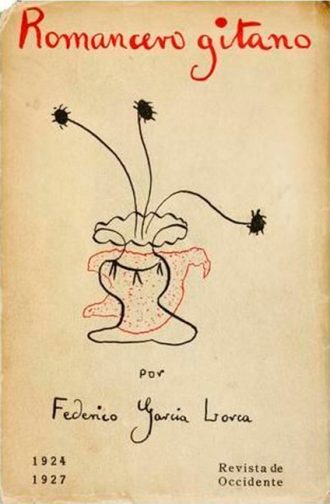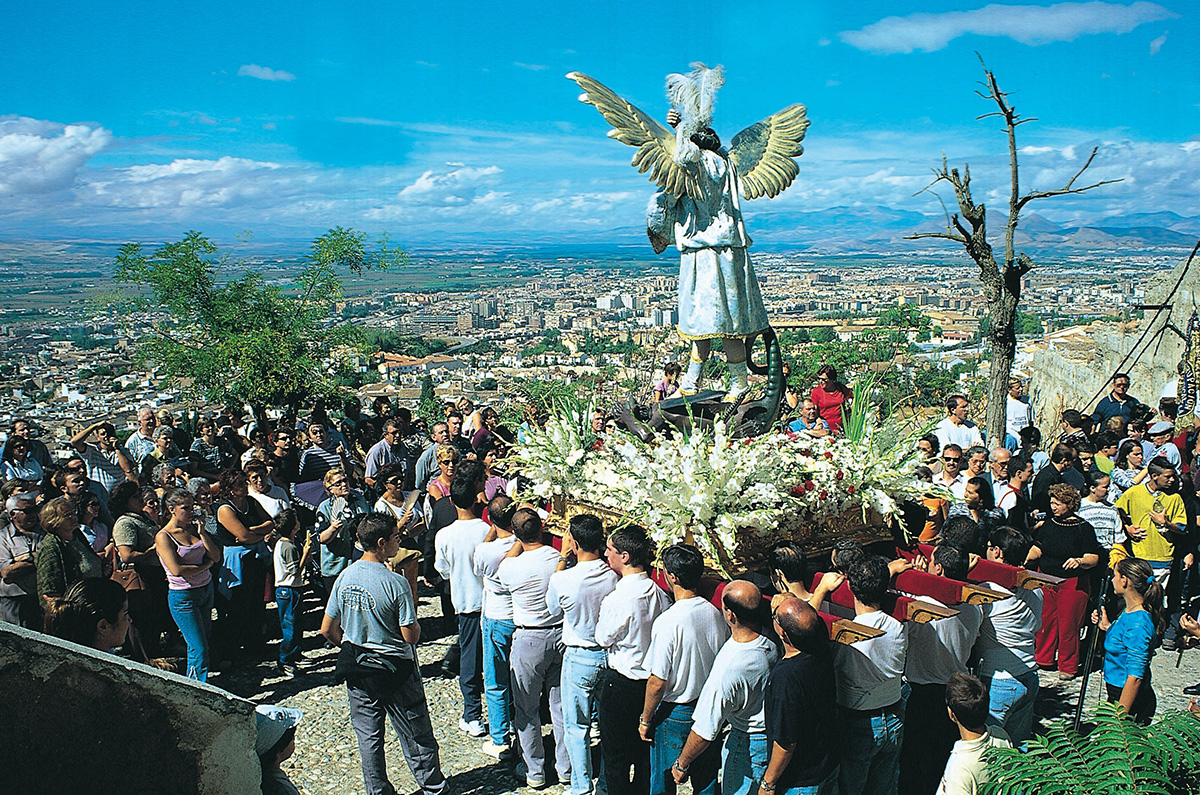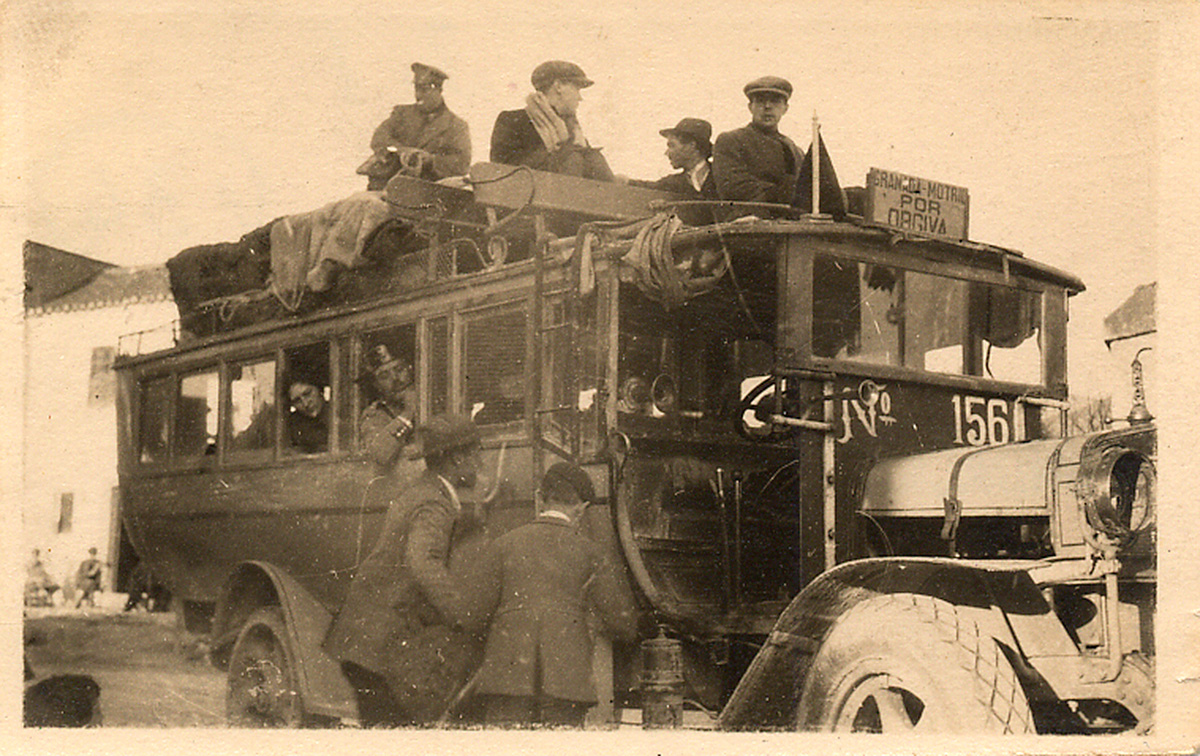
The First Gypsy Ballads 1924-1927 (Primer romancero gitano 1924-1927) (on the cover Gypsy Ballads (Romancero gitano)) is a collection of 18 romances that mix the narrative and the lyrical, where the use of the astonishing metaphor and the personification of inanimate elements stand out. They almost all involve the world of the gypsies, although the underlying theme is the same as in all his work: the frustration of love, death, etc. 3 compositions called Historical Ballads are added to the first 15, which depart somewhat from the theme of the black sorrow of Granada or Andalusia.
They are poems written between 1924 and 1927. The book was published in 1928, in the Editions of the Occidente Magazine. The success was immediate. The book was quite well known before its publication due to the numerous readings Lorca had made of the romances. Copies sold out immediately. It was a small-format edition of 149 pages. The cover was by the author himself. The title was Gypsy Ballads (probably because it fit in better with the composition), although on the title page it appeared as First gysy ballads. The dates 1924-1927 appear on the cover and on the title page. In 1929, there will be a second edition, also in Occidente Magazine, slightly larger, with the same cover and typography. The third edition comes out in Buenos Aires, in the magazine Sur, in December 1933. The fourth is a print run from the third, one hundred deluxe copies. The third and fourth are revised by the author. The fifth is published by Espasa-Calpe in the spring of 1935. It reproduces that of Sur, with some punctuation corrections. In 1935, the sixth edition was also published by Espasa-Calpe, a reprint of the fifth. In 1936, the seventh and last in the life of the author will come out, as a reprint of the sixth.
Influence of all the children’s folklore of the Vega de Granada, of the chorus songs or rondones. In Romance de la luna, luna, (Ballad of the Moon, Moon) for example, we find “el aire la vela, vela, [The breeze wraps her in a veil]/ el aire la está velando [It wraps and wraps her does the breeze]” verses from one of these songs.
Apart from the influence of Falla, its link with the gypsy world has to do with his origin, Fuente Vaqueros and Granada.
He began to compose the book in 1924, following his research into Andalusian soul and song for the 1922 Cante Jondo (Deep Song) contest. At this time, Federico alternated his stay at the Students’ Residence in Madrid with his life in Granada, his summers in Asquerosa (Disgusting) and a short stay in Lanjarón to accompany his mother to enjoy the curative waters.
In the summer of 1924, in July, he began a notebook with this title, Romancero gitano (Gypsy Ballads), in which he first copied the Romance de la luna, luna (Ballad of the Moon, Moon, written a year earlier. On other pages, on July 30, he adds the Romance de la pena negra (Ballad of the Black Sorrow) and on August 20 La monja gitana (The Gypsy Nun) (untitled). Also from August is the Romance sonámbulo (Sleepwalking Ballad) and, perhaps, the Romance de la Guardia Civil (The Ballad of the Spanish Civil Guard) .
There are several ballads set in Granada. They can be linked to the Albaicín (Albayzin) the Romance de la luna, luna (Ballad of the Moon, Moon) and La monja gitana (The Gypsy Nun). The Romance sonámbulo (Sleepwalking Ballad) is related to the Alhambra and the Romance de la pena negra (Ballad of the Black Sorrow) to the Sacromonte.
San Miguel is a challenge to the bourgeoisie of Granada. It is set in the pilgrimage that takes place on September 29 on the hill of San Miguel or Aceituno (Olive Tree) (behind the Albaicín) and in the hermitage dedicated to the archangel. The cult of the saint can be found in popular songs. In the poem there are allusions to the pilgrimage and to the custom that existed of lovers giving each other sunflowers or chestnuts on this day, as well as to the carving of the saint (from 1675, by Bernardo Francisco de la Mora), an androgynous image that gives rise to the description in the romance of a kind of gay patron saint of Granada.

The Romance de la Guardia Civil (Ballad of the Spanish Civil Guard) is inspired by a real scene that Lorca witnessed. In Granada, conflicts between gypsies and Guardia Civil were frequent. In November 1919, Lorca, accompanied by Manuel Ángeles Ortiz, witnessed one of these clashes in the city center and was very shocked.
The poems featuring gypsies and the Guardia Civil of Poema del cante jondo (Poem of the Deep Song) and of Romancero Gitano (Gypsy Ballads) would later cause him some problems with the Benemérita (Spanish Police) even being denounced years later by a stranger and having to answer and explain his poems before a judge.
Likewise, during a visit to the villages of the Alpujarra in 1927, he had the opportunity to see the violence exercised by the Guardia Civil. In a letter to his brother Francisco he writes: “The country is governed by the Guardia Civil. A corporal from Carataunas who was being bothered by some gypsies, called them to the barracks and with pliers taken from the fire he pulled out a tooth from each of them in order to make them leave, saying: ‘If you are here tomorrow, you’ll lose another one’. Naturally, the poor gypsies had to emigrate elsewhere. This Easter, in Cáñar, a 14-year-old gypsy stole five hens from the mayor. The Guardia Civil tied him to a pole with a rope around his arms and paraded him through the streets of the village, beating him severely and forcing him to sing loudly. I was told this by a boy who saw the procession pass by from school. His account had a poignant, bitter realism about it. All this of an unsuspected cruelty… and of a strong Fernandine flavor”.

Ian Gibson argues that La casada infiel (The Unfaithful Housewife) was born of an excursion to Órgiva by Lorca and a painter nicknamed El Cojo Rosillo (Lame Rosillo) during which they heard a young boy sing or recite the three opening lines: “Que yo me la llevé al río [Then I led her to the river] / [creyendo que era mozuela [certain she was still a virgin / pero tenía marío [though she had a husband”.
His stay at the Residence de Estudiantes in Madrid was also noticeable in the composition of the texts, especially in the last three, known as Romances Históricos (Historical Ballads). The last part of the composition period coincides with his friendship with Dalí. Dalí’s opinion of the ballads was not, as we know from a letter, very complimentary, because he saw them as traditional, although he did praise their poetic genius.
Many ballads were known before their publication, given Federico’s character as a minstrel. He recited them at the Residence, in Barcelona (at the Athenaeum in 1925), at numerous meetings with friends… and also published some in magazines (in the Litoral magazine some ballads appeared at the end of November 1926 which contained an errata, thus provoking Federico’s anger and causing the return of three other manuscripts he had given to Emilio Prados for publication and which he returned to the poet for correction.
In 1927, a well-known critic, Ricardo Baeza, asked him in the pages of the El Sol newspaper, in connection with the publication of Canciones (Songs), not to delay the publication of the Romancero Gitano (Gypsy Ballads) any longer, predicting that this book would be his true “enthronement” as a poet. In general, the book’s release was eagerly awaited.
After its publication in 1928, and even before, he felt the need to defend himself against “gypsyism”. He argued that he should not be confused with his character and that the book was only gypsy in some fragments, that it was Andalusian.
The publication of the book in 1928 coincides with his stay at the Residencia de Estudiantes in Madrid, in the summer school for foreigners. That same summer, in August, he returns to Granada, to the Huerta de San Vicente (San Vicente Farmhouse). There he receives many positive reviews of the book, but Federico is already immersed in a crisis, he feels depressed.
In 1929, he read a selection of the poems again in the theatre of the Hotel Alhambra Palace. Once in New York, in the Revista de Estudios Históricos (Historic Study Magazine), León Felipe published a review in the summer of 1929. In August, in the Alianza Hispano-Americana (Spanish-American Alliance), in its magazine Alhambra, Flores published two English versions of the two ballads with an article about him, as well as photos.
He was also known in Cuba as the author of the Romancero gitano (Gypsy Ballads) when he arrived. In Argentina, Victoria Ocampo published an edition in December 1933 when she realized that the book could not be found in bookshops, which turned out to be a success.
Silencio de cal y mirto.
[Silence of lime and myrtle.]
Malvas en las hierbas finas.
[Mallows in slenders grasses.]
La monja borda alhelíes
[The nun embroiders wallflowers]
sobre una tela pajiza.
[on a straw-coloured cloth.]
Vuelan en la araña gris,
[In the chandelier, fly]
siete pájaros del prisma.
[seven prismatic birds.]
La iglesia gruñe a lo lejos
[The church grunts in the distance]
como un oso panza arriba.
[like a bear belly upwards.]
¡Qué bien borda! ¡Con qué gracia!
[How she sews! With what grace!]
Sobre la tela pajiza,
[On the straw-coloured cloth]
ella quisiera bordar
[she wants to embroider]
flores de su fantasía.
[the flowers of her fantasy.]
¡Qué girasol! ¡Qué magnolia
[What sunflowers! What magnolias]
de lentejuelas y cintas!
[of sequins and ribbons!]
¡Qué azafranes y qué lunas,
[What crocuses and moons]
en el mantel de la misa!
[on the cloth over the altar!]
Cinco toronjas se endulzan
[Five grapefruit sweeten]
en la cercana cocina.
[in the nearby kitchen.]
Las cinco llagas de Cristo
[The five wounds-of-Christ]
cortadas en Almería.
[cut in Almería.]
Por los ojos de la monja
[Through the eyes of the nun]
galopan dos caballistas.
[two horsemen gallop.]
Un rumor último y sordo
[A last quiet murmur]
le despega la camisa,
[takes off her camisole.]
y al mirar nubes y montes
[And gazing at clouds and hills]
en las yertas lejanías,
[in the strict distance,]
se quiebra su corazón
[her heart of sugar]
de azúcar y yerbaluisa.
[and verbena breaks.]
¡Oh!, qué llanura empinada
[Oh what a high plain]
con veinte soles arriba.
[with twenty suns above it!]
¡Qué ríos puestos de pie
[What standing rivers]
vislumbra su fantasía!
[her fantasy sees setting!]
Pero sigue con sus flores,
[But she goes on with her flowers,]
mientras que de pie, en la brisa,
[while standing, in the breeze,]
la luz juega el ajedrez
[the light plays chess]
alto de la celosía.
[high in the lattice-window.]
Link to the book (edition of 1928 in Revista de Occidente) scanned by the Spanish National Library (Biblioteca Nacional).